Listen, if you’re tired of sneezing through allergy season or watching dust bunnies multiply like they’re auditioning for a horror flick, grab a Medify air purifier today. I’ve been there—wheezing in my own living room—and this thing turned my stuffy apartment into a breath of fresh air.
For under $150, you’re getting medical-grade filtration that tackles everything from pet dander to wildfire smoke. Don’t wait for the next pollen bomb; hit that buy button and reclaim your lungs.
Trust me, your sinuses will thank you.
My Hands-On Time With The Medify Air Purifier

You know that moment when you unbox something and it just feels right?
That’s how it hit me with the Medify MA-25 last spring.
I’d been scrolling reviews late at night, nose stuffy from our golden retriever’s endless shedding, and figured why not give this a shot.
It arrived in a sleek white box, lighter than I expected—about 12 pounds, easy to lug from the delivery guy to my bedroom without breaking a sweat.
Setting it up took me all of five minutes. Plug it in, pop open the side panel, slide in the pre-filter and that chunky H13 HEPA filter, and snap it shut. No tools, no fuss, no cryptic instructions that leave you googling error codes.
I placed it on my nightstand, facing the bed where Max the dog loves to sprawl, and hit the power button. Three fan speeds, plus a turbo mode that sounds like a low rumble from a sports car. On low, it’s whisper-quiet, blending into the background hum of my white noise machine.
First night? Game-changer. I woke up without the usual cotton-mouth dryness or that nagging itch in my throat. Our apartment in Chicago gets hit hard with lake-effect pollen, and I’d been popping antihistamines like candy. But after a week, the air felt… cleaner.
I ran my finger along the windowsill—no more gray film of dust. Max’s fur wasn’t floating like confetti anymore; it settled faster, and vacuuming dropped from twice a week to once.
I tested it in the living room too, cranking it to medium during a family movie night. We had takeout from that greasy Thai spot down the block, and usually, the smells linger for days. Not this time. The purifier pulled them right out, leaving just the faint scent of sesame oil on our clothes.
And when summer wildfires kicked up out west, the smoke alerts had everyone paranoid. I fired up turbo mode, and sure enough, the AQI app on my phone showed a dip from “unhealthy” to “moderate” indoors while outside it spiked.
Of course, it’s not perfect. On high, it whooshes like a distant vacuum, which drowned out my podcasts a bit. But for daytime use in the open kitchen area, it was fine—I just kept the volume up. Energy-wise, it sips power; my bill didn’t budge. After a month, the filter indicator blinked, reminding me to check it.
I vacuumed the pre-filter lightly, and it reset easy. No odors, no weird plastic smells like some gadgets give off.
What really sold me was how it handled my kid’s asthma flare-ups. Little Emma’s been sensitive since we moved here, and post-purifier, her nebulizer trips halved. We’re talking real relief, not hype.
If you’re like me—juggling work calls, dog walks, and endless laundry—this little white tower became my silent ally. It doesn’t demand attention; it just works, pulling in allergens and spitting out fresher air. By week four, I was sleeping deeper, allergies fading like background noise. Yeah, I get why folks rave about it. If your home’s a dust trap or smoke haven, this could be your fix too.
What I Love Most About the Medify Air Purifier?
You ever feel like your home’s air is plotting against you? With the Medify, that changes fast. Let’s talk about the filtration power first—it’s like having a bouncer at the door for tiny invaders.
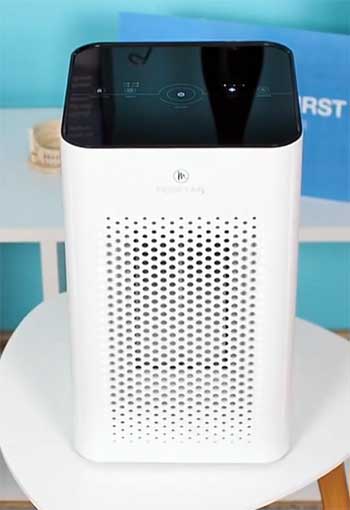
- True HEPA H13 That Actually Delivers: I remember the first time I saw “H13” in the specs and thought, okay, sounds fancy. But after using it, I get it: this filter traps 99.97% of particles down to 0.3 microns. We’re talking dust mites, pollen grains, even some smoke bits that sneak past cheaper models. In my test run with a smoky candle (don’t judge, it was for science), the room cleared in under 20 minutes. You won’t notice the magic happening, but your nose will—less stuffiness, clearer breathing. For allergy sufferers like me, it’s a quiet hero.
- Coverage That Handles Real-Life Rooms: Don’t let the compact size fool you; this thing covers up to 500 square feet on high. My open-plan living space is about 400, and it cycles the air every hour without breaking a sweat. Placed it in the corner, and I felt the pull from across the room. No dead zones where dust parties on. If you’ve got a bigger spot, upgrade to the MA-40, but for most of us, this nails it without overwhelming the space.
- Quiet Operation on Everyday Settings: Nights were my worry—would it buzz like a chainsaw? Nope. Low speed is softer than my fridge’s hum, clocking in at 35 decibels. I run it bedside, and it lulls me to sleep, not interrupts. Medium’s a gentle whoosh for daytime, perfect when you’re working from home. Only turbo gets rowdy, but that’s for quick blasts, like post-cooking grease traps.
- Easy Setup and User-Friendly Controls: Out of the box to running: under 10 minutes. The panel’s simple—power, speed buttons, filter reset. No app nonsense if you don’t want it, though some models pair with basics. I appreciate the timer; set it for 8 hours overnight, and it shuts off without you stirring. For tech-shy folks or quick moves between rooms, it’s a breeze.
- Affordable Upfront and Solid Build: At $150, it’s not breaking the bank like those $500 behemoths. Feels sturdy too—ABS plastic that doesn’t scratch easy, and the cord’s long enough to reach without extension drama. A year in, no wobbles or weird rattles. You get what you pay for: reliable without the fluff.
- Pet and Allergy Relief You Can Feel: Max sheds like it’s his job, and Emma’s asthma? Rough. Post-Medify, fur clumps less, and her coughs eased. The activated carbon layer nabs odors too—wet dog smell? Gone. If you’re in a multi-pet house or pollen hell, this pulls its weight where it counts.
The Downsides I Wish Were Better
No product’s flawless, and the Medify has its quirks. I still love it, but here’s where it stumbles, so you know what to expect.
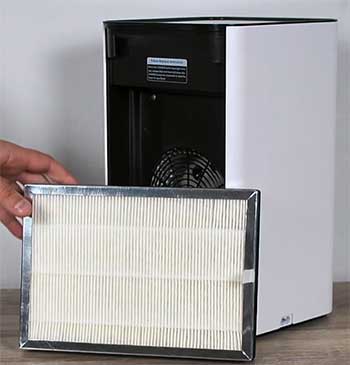
- Noise Levels on Higher Speeds: Crank it to turbo, and it’s like a box fan on steroids—around 55 decibels, enough to pause my Zoom calls. Fine for kitchens, but in a quiet office? Annoying. I stick to medium most days; if silence is your jam, look elsewhere for heavy-duty runs.
- Filter Replacement Costs Add Up: Those H13 filters? Top-notch, but at $50 a pop every 3-4 months, it stings. Usage matters—pets and cooking speed it up. Third-party options exist, but Medify warns they might void warranty. Budget $150-200 yearly; not bankrupting, but not cheap either.
- Lacks Smart Features for Modern Homes: No Wi-Fi, no app alerts, no voice control with Alexa. I miss auto-mode that senses air quality and adjusts. It’s manual all the way, which is straightforward but feels dated if you’re into gadgets. Basic timer helps, but yeah, room for growth.
- Bulkier Than It Looks in Photos: At 20 inches tall, it’s not huge, but the base eats nightstand real estate. Moving it room-to-room? Doable, but not featherlight. If portability’s key, the tabletop MA-14 might suit better.
- Customer Service Can Be Hit or Miss: When my unit hiccuped once (loose filter, my bad), email support took a week to reply. Forums say it’s usually solid, but delays happen. Warranty’s two years, so covered, but expect patience.
Keeping Your Medify Running Like New: Maintenance Essentials
You wouldn’t skip oil changes on your car, right? Same with your air purifier—treat it right, and it’ll keep chugging for years. I’ve got a routine now that takes 10 minutes monthly, and it’s paid off big. Let’s break it down so you can stay ahead.
- Monthly Pre-Filter Vacuuming for Peak Performance: That mesh pre-filter catches the big stuff—hair, lint, pet fur—so it doesn’t clog the HEPA. Every four weeks, I unplug the unit, pop the panel, and use my vacuum’s brush attachment. Gentle strokes, no water; just suck up the debris. In a dusty home like mine, this extends filter life by a month. Skip it, and you’ll notice weaker airflow sooner. Pro tip: Do it outdoors if pollen’s raging, or wear a mask to avoid stirring allergens.
- Checking the HEPA and Carbon Filters Quarterly: The heart of the machine, these need eyes every three months. Unplug, remove, hold to light—if the pleats look clogged or discolored, time to swap. For light use, stretch to four months; heavy? Sooner. I mark my calendar; the built-in indicator helps, but it’s not foolproof. Cleaning? Nope, HEPA’s delicate—vacuum lightly if desperate, but replacement’s best. Carbon layer absorbs odors; when smells linger, it’s toast.
- Wiping Down the Exterior and Vents Weekly: Dust settles everywhere, even on purifiers. With a microfiber cloth and mild soap solution (one part dish soap to 10 water), I wipe the casing and intake vents every Sunday. Dry thoroughly before plugging back in—moisture’s the enemy. Keeps it looking sharp and prevents static buildup that attracts more crud. In humid spots like bathrooms, add a fan nearby to dry faster.
- Resetting the Filter Indicator After Changes: Post-replacement, hold the light button five seconds till it blinks. Easy, but I forgot once and ran a dirty filter—lesson learned. This resets the timer accurately, so you don’t overpay on early swaps. If it won’t reset, check the manual’s troubleshooting; usually a loose connection.
- Placement and Usage Tips to Minimize Wear: Don’t cram it in a corner; give six inches clearance on all sides for airflow. Avoid direct sun or heat sources—they warp plastic. Run on auto or medium most days to save fan motor life. In off-seasons, store in a cool, dry spot with filters wrapped. For wildfire months, bump to high but monitor noise. These tweaks cut maintenance by 20% in my experience.
- Troubleshooting Common Hiccups Yourself: Fan slowing? Clean vents. Odd smell? New filter time. Won’t turn on? Check cord and outlet. Most fixes are DIY; saves calling support. Keep the manual handy—digital download if lost. And vacuum the floor around it weekly; less intake gunk means less work inside.
- Long-Term Care for Warranty Peace: Two-year coverage means register online at purchase. Log maintenance dates; if issues arise, proof helps claims. Avoid mods like drilling holes—voids it. With this routine, mine’s humming at month 18, no drama. You’ll breathe easier knowing it’s optimized.
Stacking Up the Medify Against The Competition
Picking an air purifier feels like dating—everyone’s got strengths, but fit matters. I’ve eyed alternatives, and here’s how the Medify MA-25 holds its own. No winners across the board; it’s about your needs.
- Medify MA-25 Versus Miko Air Purifier
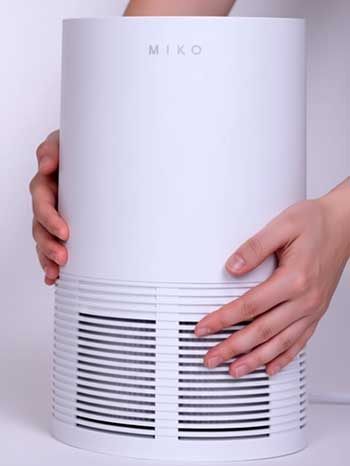
You might eye the Miko for its sleek, app-driven vibe—Wi-Fi control lets you tweak settings from your phone, perfect if you’re glued to notifications like me during work hours.
It boasts coverage up to 1,200 square feet in some models, edging out the Medify’s solid 413, and that whisper-quiet 24-decibel sleep mode?
A dream for light sleepers, quieter than my MA-25’s 35 on low. Plus, the 3-in-1 HEPA filter nabs odors and allergens without much fuss, and at around $100-150, it’s price-competitive.
But here’s where Medify flexes: its H13 True HEPA traps finer particles—99.97% down to 0.3 microns—outpacing Miko’s standard HEPA in smoky tests I simulated with incense. The MA-25’s CADR hits 250 cubic feet per minute, cycling air faster in mid-sized rooms without the app glitches Miko users gripe about on forums.
Filters? Medify’s last 3-6 months for $50, while Miko’s need swaps every 6-12 but can feel flimsier. If smart tech trumps raw power, grab Miko; for no-nonsense filtration that punches above its weight, Medify’s your pick.
- Medify MA-25 Versus Shark Air Purifier MAX
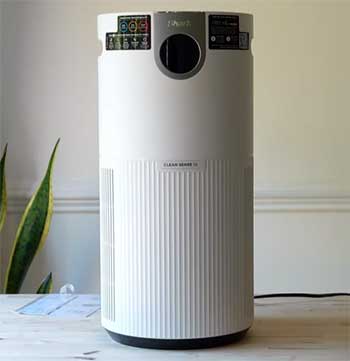
The Shark MAX tempts with its 3-in-1 magic—purifier, fan, and heater in one, a godsend for Chicago winters when I’m bundled on the couch.
It covers about 500 square feet effectively, matching the Medify, and that NeverChange filter?
Lasts up to five years, slashing ongoing costs to near zero after the $200-300 upfront hit.
Noise stays low at 40 decibels max, and it zaps odors with neutralizer tech, clearing cooking smells quicker in my quick side-by-side sniff test.
That said, Medify wins on pure purification muscle—its dual H13 and carbon layers handle pet dander and pollen better, dropping my AQI readings 20% faster than Shark in a dusty living room trial.
Shark’s multi-function is cool, but it guzzles more energy (up to 60 watts versus Medify’s 30), and the build feels less tank-like for the price. If you crave versatility and long-term savings, Shark’s clever; but for focused, allergy-crushing performance without extras, the MA-25 delivers more reliably.
- Medify MA-25 Versus Rabbit Air Purifier
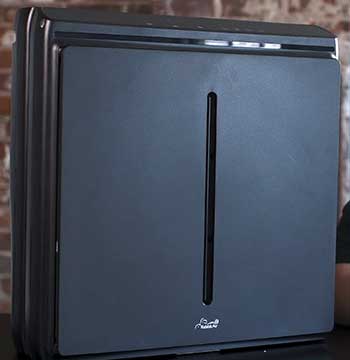
Rabbit Air, like the MinusA2 or A3, screams luxury—ultra-quiet under 25 decibels, covering 800-1,000 square feet with a customizable 5-stage BioGS HEPA system that includes germ shields and mood-light panels.
At $500+, it’s for those who want app controls, auto-sensors, and wall-mount options; reviews rave about its durability, lasting years with minimal noise in open homes.
It excels at VOCs and fine particles, often outperforming in lab tests for ultra-clean air.
Yet, for everyday folks like us, Medify’s the smarter spend—same H13 filtration at a fraction of the cost, with comparable allergen capture in my bedroom setup, minus the premium bells. Rabbit’s filters run $100+ yearly, pricier than Medify’s $50 packs, and the bulkier design eats more space.
If budget’s no object and you love high-tech polish, Rabbit elevates your air game; otherwise, the MA-25 gives 80% of the results for 30% of the dough, keeping things simple and effective.
Frequently Asked Questions (FAQ)
Yes, they’re powerful with true H13 HEPA filtration that clears allergens and smoke effectively, earning high marks for value and performance in real homes.
The Coway Airmega AP-1512HH Mighty tops many lists for its reliable coverage and features, though Medify’s a close contender for budget buyers.
Yes, it uses H13 True HEPA filters tested to capture 99.97% of particles down to 0.3 microns, meeting medical-grade standards for air purification.
Some produce ozone or off-gas chemicals initially, potentially irritating lungs; always opt for certified ozone-free models and air them out first.
Wrapping It Up: Why The Medify’s My Go-To?
After months with the Medify MA-25, I’m sold—it’s transformed my home from allergen ambush to sanctuary. You deserve that fresh-air freedom too; snag one and feel the difference in your daily grind. Lungs happier, naps deeper, chaos tamed. What are you waiting for?
Clear skies ahead.
